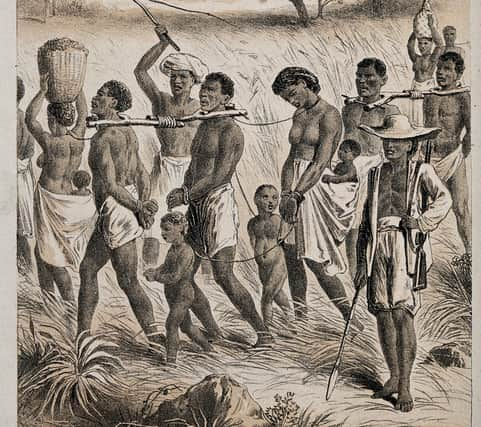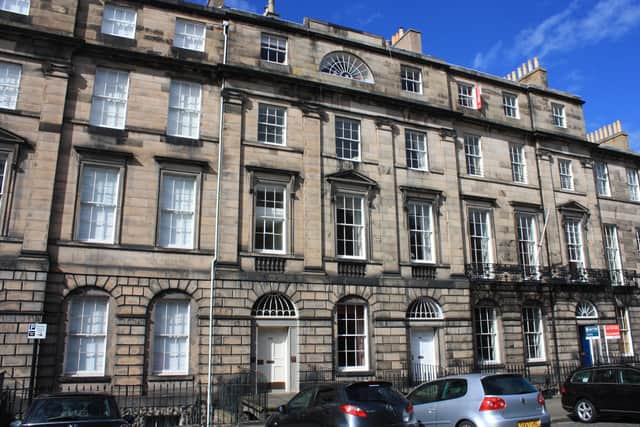Map plots riches of Edinburgh slave owners


The map, created by University College London, gives a fascinating insight into the people who made their riches on the back of slavery.
Those who feature include the plantation owners who returned to Edinburgh following abolition, as well as the city’s doctors and lawyers who supplemented their wealth by slavery.
Advertisement
Hide AdAdvertisement
Hide AdIt also highlights the case of a 15-year-old girl orphan girl who lived in one of Edinburgh’s finest addresses and inherited slaves and land followng the death of her father.


The map shows those who received money following the 1833 Slavery Aboliton Act and the subsequent laws passed to compensate slave owers for their loss of ‘property’. It also lists those key legal establishment figures who represented slave owners in their quest for riches.
Around 130 records have been plotted on the Edinburgh map so far as part of the ongoing Legacies of British Slave Ownership project at UCL with work continuing to create the full picture of how slave money filtered back into the capital and the country at large.
Among those who received the highest payments in Edinburgh was Thomas Duncan, a former planter of Grenada, who lived at 78 Great King Street with his wife, five children and five female servants.
Advertisement
Hide AdAdvertisement
Hide AdHe owned a total of 332 slaves across three estates and in 1835 was awarded a total of £1.08m at today’s values.
Nearby in Albany Street, Alexander Murchison, a doctor who practised in Jamaica and who later bought a plantation there, was awarded £255,000 in 1835 for his land and 191 slaves kept at his two estates at Jamaica Vere.
While overseas, Murchison, who qualified as a doctor from Marischal College in Aberdeen, became an elected member of the Jamaica House Assembly, the legislature of the British colony of Jamaica.
In total, he was awarded the equivalent of £444,307 at today’s values for the loss of his slaves following abolition with Murchison returning to his native Elgin thereafter.
Advertisement
Hide AdAdvertisement
Hide AdOver in West Dundas Street, John McGlashan, an attorney in Jamaica, was awarded compensation along with his wife Eliza, for their share in the Dunbarton estate in St Ann’s, where 194 slaves were kept.
In 1836, the couple received just over £21,000 at today’s values with Mrs McGlashan’s three sisters also receiving a payment.
At 1 Gayfield Square, another interesting case is highlighted on the UCL map.
It relates to Elizabeth Lambie, a child at the time of emancipation, who went on to inherit land and slaves owned by her attorney father William at St Thomas-in-the-East, Jamaica, following his death,
Advertisement
Hide AdAdvertisement
Hide AdThere were 160 slaves on the Friendship estate co-owned by her father with records showing around £360,000 at today’s values was paid out in relation to the land and people held there.
Elizabeth Lambie received a share of this payment when she was 15 although it is not clear how much she gained, given it was paid to her two guardians.
Family records show the girl lived a Gayfield Square with her great aunt and her aunt, Sarah Jane Chrichton, who was in 1860 “living in the highest respectability in Edinburgh acting as a second mother to her orphan niece Elizabeth Jane Lambie”.
To access the UCL map, visit ucl.ac.uk
A message from the Editor:
Thank you for reading this story on our website. While I have your attention, I also have an important request to make of you.With the coronavirus lockdown having a major impact on many of our advertisers - and consequently the revenue we receive - we are more reliant than ever on you taking out a digital subscription.Subscribe to scotsman.com and enjoy unlimited access to Scottish news and information online and on our app. With a digital subscription, you can read more than 5 articles, see fewer ads, enjoy faster load times, and get access to exclusive newsletters and content. Visit https://www.scotsman.com/subscriptions now to sign up.
Advertisement
Hide AdAdvertisement
Hide AdOur journalism costs money and we rely on advertising, print and digital revenues to help to support them. By supporting us, we are able to support you in providing trusted, fact-checked content for this website.
Joy Yates
Editorial Director